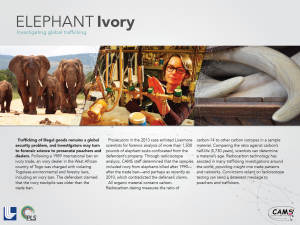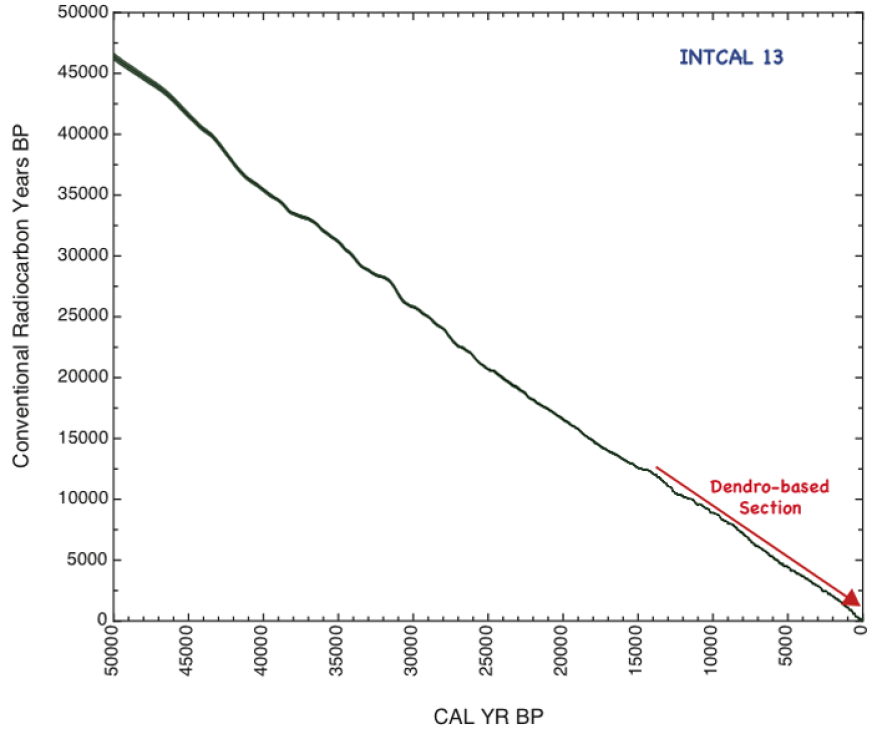With regards to geochronology, radiocarbon is both blessed and cursed–the boon is that it is ubiquitous in nature and often we can date the exact carrier of the biogeochemical or paleoclimate proxy that we are studying, including studying the carbon cycle.
However, due to the variable production of 14C, and its partitioning between the atmosphere-ocean-land reservoirs, a fundamental tenet of decay-based radioisotope geochronology is invalidated: namely the initial 14C/12C ratio is not constant with time nor throughout the Earth's reservoirs ![]() . Non-constant 14C/12C in the Earth's reservoirs through time requires that conventional 14C ages be "calibrated" to obtain ages on an absolute or calendric time-scale (cal yrs BP).
. Non-constant 14C/12C in the Earth's reservoirs through time requires that conventional 14C ages be "calibrated" to obtain ages on an absolute or calendric time-scale (cal yrs BP).
Calibrated ages are not conventional radiocarbon years with 1950 subtracted. Depending on the depositional environment and material being analyzed, additional corrections may be required. For instance, in the ocean, one needs to account for the apparently older 14C ages of carbon in surface ocean waters compared to the atmosphere (i.e., an oceanic reservoir effect). A similar correction is required in karstic terrain lakes due to the addition of old, 14C-free carbon (i.e., a hard water effect caused by the material being dated deriving some of its carbon from lake dissolved inorganic carbon). Soft-water lakes in recently glaciated terrain may also exhibit a reservoir effect in the first centuries after the establishment of such lakes. Unfortunately, it is most often impossible to precisely and accurately constrain past reservoir and hard/soft water variability. GCM models with carbon isotopes have a very hard time getting the modern distribution correct for the right reasons and thus should be used with extreme caution, if at all, for calibration activities.
In developing the calibrated timescale, preference is given to those archives that directly record atmospheric 14CO2 and have the ability for uniquely defined annual chronologies—for these reasons (among others) the overlapping and replicated tree-ring chronologies that make up the backbone of the International (14C-Calendar) Calibration curve (INTCAL) are considered the "gold standard." Due to the paucity of overlapping tree-ring sequences older than the late deglacial, the extension of the calibration time-scale has relied upon a series of secondary archives from the land and ocean. As new potential 14C-calibration data and records are published these records are assessed and it is determined whether or not they are appropriate to be included in the calibration ![]() .
.
At present, the internationally agreed upon calibration timescale ![]() (Figure 2) extends to 50,000 years cal BP. The calibration curve is not created in a vacuum. In addition to pursuing their own research participants of the INTCAL radiocarbon community work with an external advisory board. Major updates to the INTCAL 14C-calendar calibration data are presented at the International Radiocarbon Conference which occurs every 3 years and, prior to being released, the calibration data and statistical based curve is discussed and ultimately, voted on.
(Figure 2) extends to 50,000 years cal BP. The calibration curve is not created in a vacuum. In addition to pursuing their own research participants of the INTCAL radiocarbon community work with an external advisory board. Major updates to the INTCAL 14C-calendar calibration data are presented at the International Radiocarbon Conference which occurs every 3 years and, prior to being released, the calibration data and statistical based curve is discussed and ultimately, voted on.
General Resources (not all inclusive, but a good start):
Queen's University, Belfast:
Oxford University Radiocarbon Unit:
Paleoclimate/Environmental Databases:
There is significant intellectual and scientific overlap between CAMS' radiocarbon and cosmogenic isotope geochronology activities. Please check out the Earth System Processes competency for additional information.







